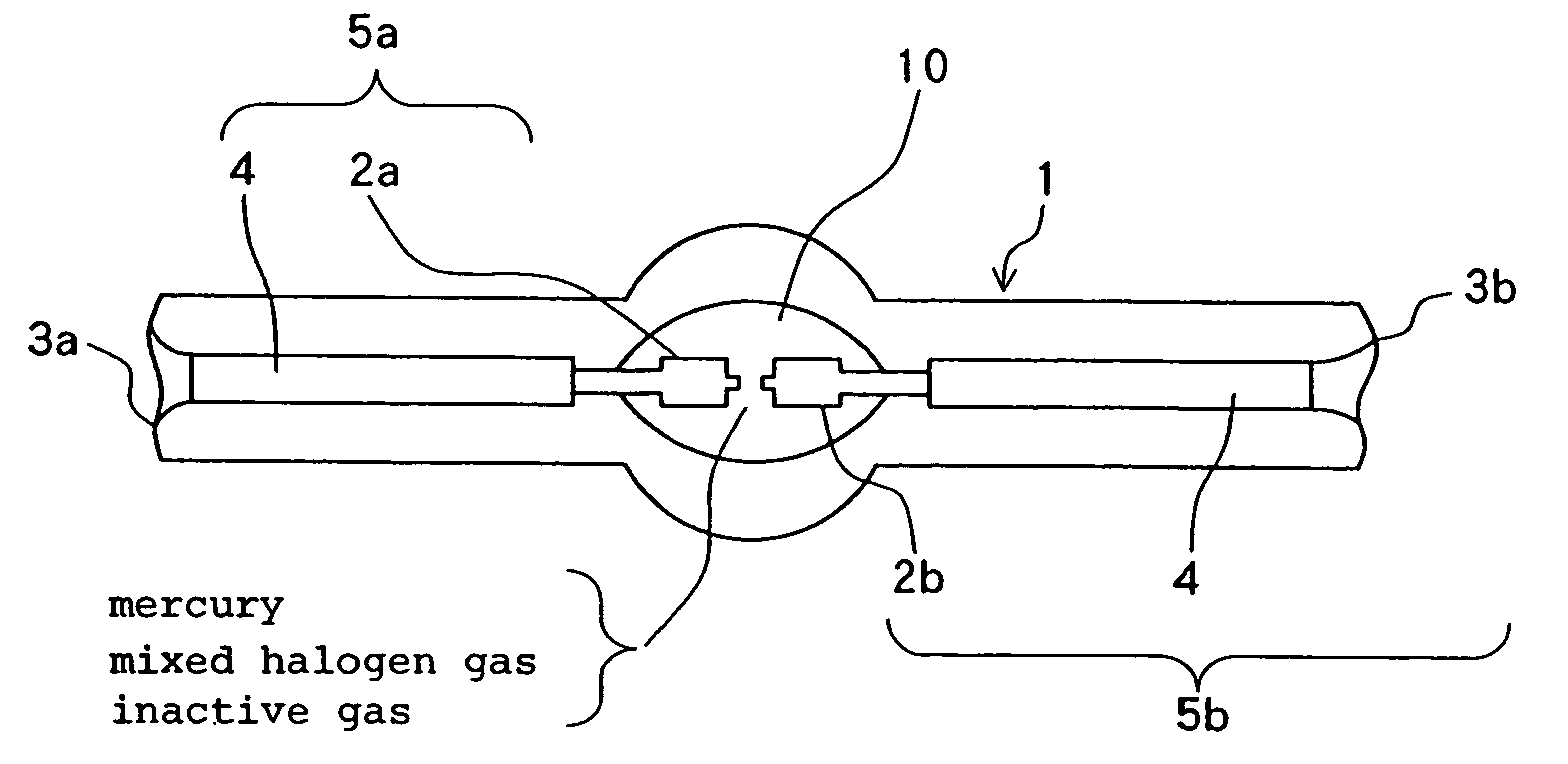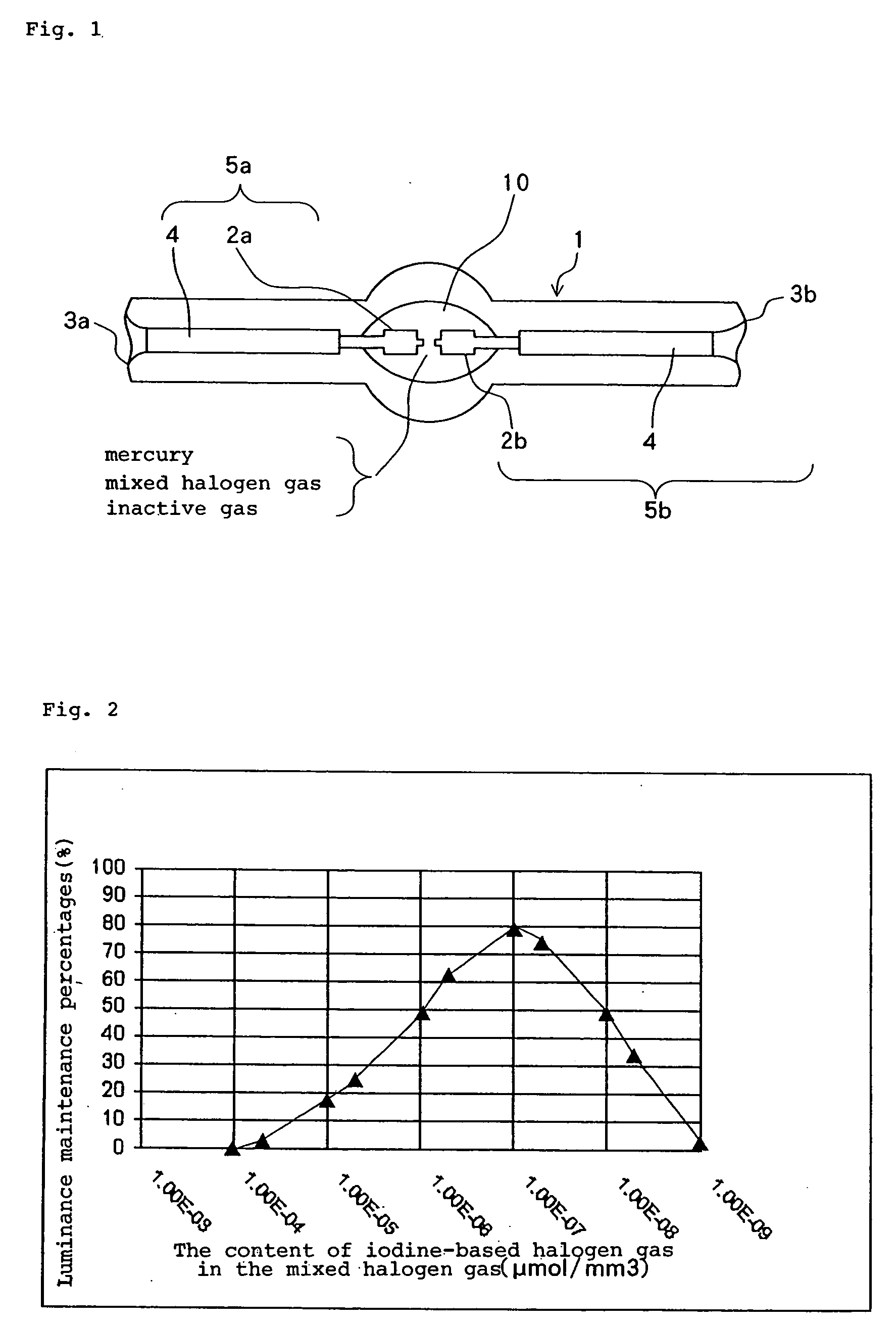High-pressure discharge lamp and method of manufacturing high-pressure discharge lamp
a technology of discharge lamp and discharge lamp, which is applied in the manufacture of electric discharge tube/lamp, cold cathode, and electric discharge system. it can solve the problems of lowering the luminance of the discharge lamp, rupturing the lamp bulb, and gas leakage from the lamp bulb
- Summary
- Abstract
- Description
- Claims
- Application Information
AI Technical Summary
Benefits of technology
Problems solved by technology
Method used
Image
Examples
1st embodiment
[0021]FIG. 1 shows in schematic cross section a high-pressure discharge lamp according to an embodiment of the present invention. As shown in FIG. 1, the high-pressure discharge lamp has lamp bulb 1 of silica glass with substantially spherical discharge space 10 defined centrally in its longitudinal direction, and a pair of electrodes 2a, 2b disposed in discharge space 10 in confronting relation to each other. The relationship between inner surface area S (mm2) of the bulb wall defining the discharge space 10 and electric power P (W) applied to the high-pressure discharge lamp is established such that bulb wall load L (W / mm2) is in the range of 0.8≦L<1.0.
[0022] Electrodes 2a, 2b are made of tungsten and are inserted from respective insertion holes 3a, 3b defined in the opposite ends of lamp bulb 1. Insertion holes 3a, 3b are hermetically sealed by rear portion of respective electrodes 2a, 2b which are covered with respective sheets of molybdenum foil 4 serving as a thermal buffer. ...
2nd embodiment
[0048] A high-pressure discharge lamp according to a second embodiment of the present invention will be described below. The high-pressure discharge lamp according to the second embodiment has a basic structure identical to that of the high-pressure discharge lamp shown in FIG. 1. Only those portions of the high-pressure discharge lamp according to the second embodiment which are different from the high-pressure discharge lamp shown in FIG. 1 will be described below.
[0049] According to the second embodiment, the relationship between inner surface area S (mm2) of the bulb wall defining the discharge space and electric power P (W) applied to the high-pressure discharge lamp is established such that bulb wall load L (W / mm2) is in the range of 1.0≦L−7 μmol / mm3 to 10−5 μmol / mm3 and an iodine-based halogen gas and / or a chlorine-based halogen gas whose content in the mixed halogen gas is one digit smaller than the bromine-based halogen gas.
[0050] The high-pressure discharge lamp accordin...
3rd embodiment
[0052] A high-pressure discharge lamp according to a third embodiment of the present invention will be described below. The high-pressure discharge lamp according to the third embodiment has a basic structure identical to that of the high-pressure discharge lamp shown in FIG. 1. Only those portions of the high-pressure discharge lamp according to the third embodiment which are different from the high-pressure discharge lamp shown in FIG. 1 will be described below.
[0053] According to the third embodiment, the relationship between inner surface area S (mm2) of the bulb wall defining the discharge space and electric power P (W) applied to the high-pressure discharge lamp is established such that bulb wall load L (W / mm2) is in the range of 1.2≦L−6 μmol / mm3 to 10−4 μmol / mm3 and an iodine-based halogen gas and / or a bromine-based halogen gas whose content in the mixed halogen gas is one digit smaller than the chlorine-halogen gas.
[0054] The high-pressure discharge lamp according to the t...
PUM
 Login to View More
Login to View More Abstract
Description
Claims
Application Information
 Login to View More
Login to View More - R&D
- Intellectual Property
- Life Sciences
- Materials
- Tech Scout
- Unparalleled Data Quality
- Higher Quality Content
- 60% Fewer Hallucinations
Browse by: Latest US Patents, China's latest patents, Technical Efficacy Thesaurus, Application Domain, Technology Topic, Popular Technical Reports.
© 2025 PatSnap. All rights reserved.Legal|Privacy policy|Modern Slavery Act Transparency Statement|Sitemap|About US| Contact US: help@patsnap.com



